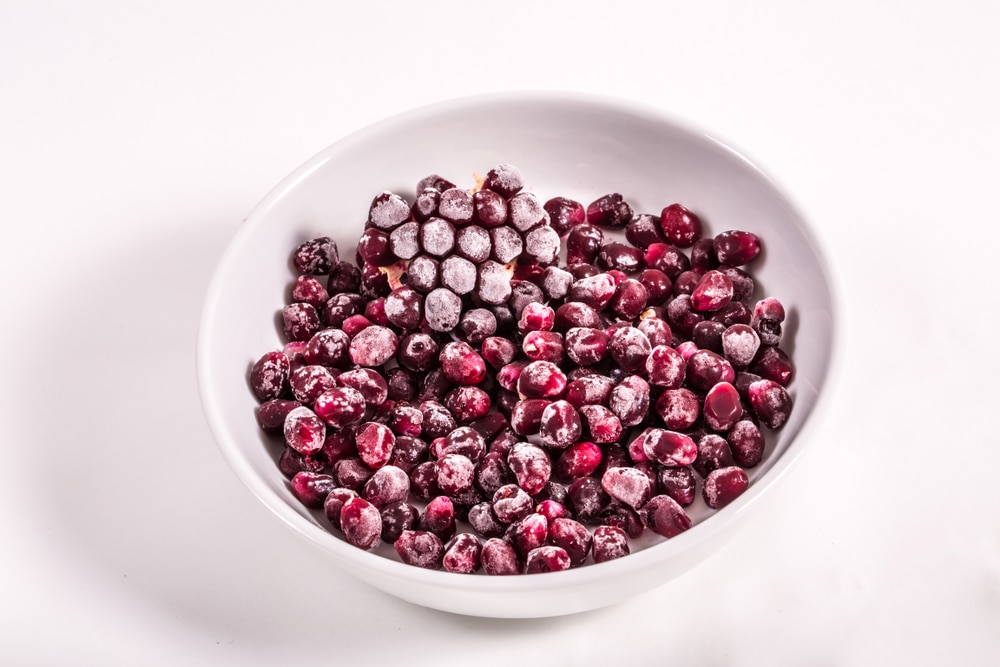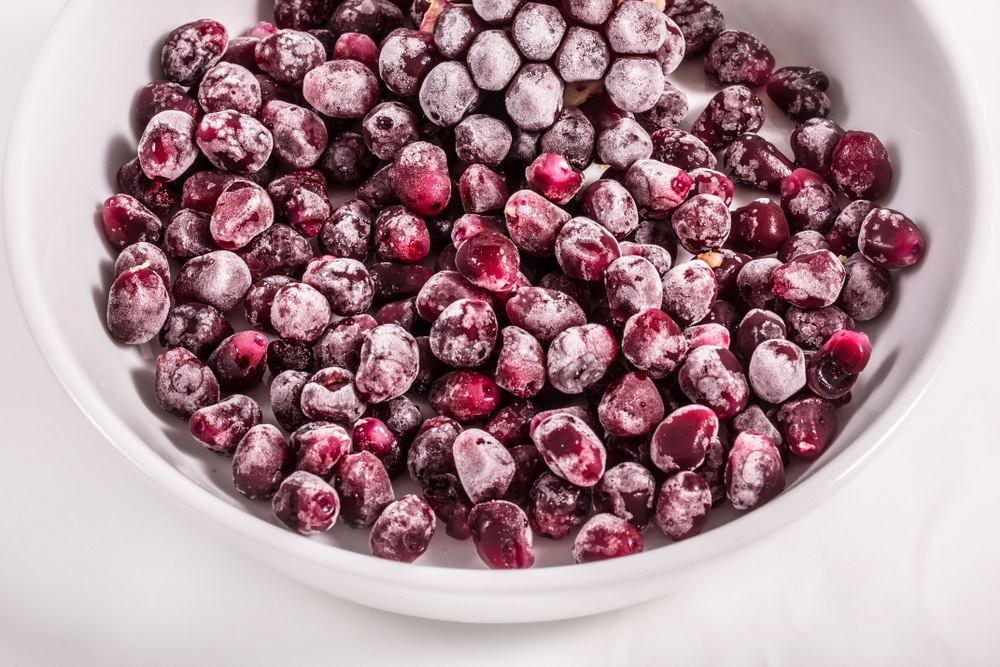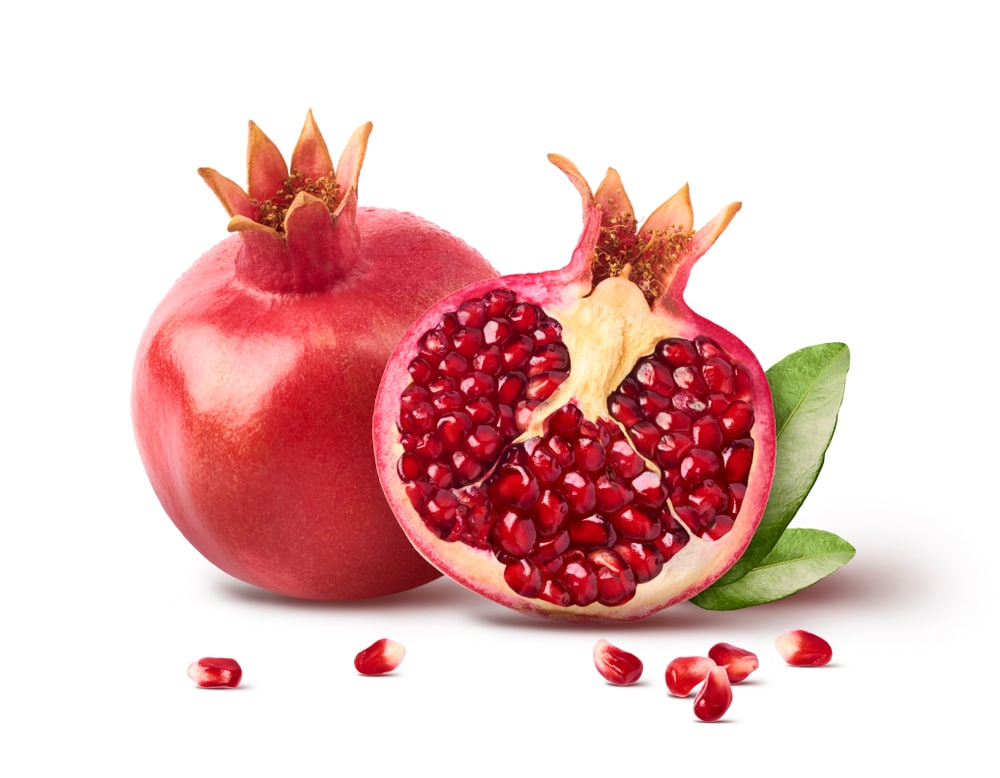You can freeze pomegranate seeds. In fact, it is a straightforward process. Frozen pomegranate seeds are also easy to use in a variety of dishes.
Pomegranates are an ancient fruit that humans have been eating for a long time. Also, they are rich in fiber and vitamins, and many people love them for their tastiness and health benefits.
Unfortunately, pomegranates can be a bit pricey, so you may find yourself wanting to freeze the edible part of the fruit for later use. Read on to find out how!

Can Pomegranate Seeds be Frozen?
Yes, you can freeze pomegranate seeds. It is a simple and nearly effortless process.
In the following sections, the process of cutting, deseeding, and freezing the pomegranate arils is laid out in easy-to-follow guides.
Processing Before Freezing
Cutting fruit seems pretty straightforward, right? The pomegranate, however, needs special considerations. How do you cut it without damaging all those tiny seeds, or arils, which are the edible part after all? Next, you’ll need to remove the seeds from the skin. Follow the steps below to cut and deseed a pomegranate successfully.
Cutting the Pomegranates
- It’s a good idea to protect your countertop with a cloth or towel; pomegranate juice stains.
- Firmly roll the pomegranate with the flat of your hand; this loosens the seeds.
- Cut off the top of the pomegranate, or “flower.”
- Look for the white sections that occur naturally in the fruit called “ridges.” You will want to slice it in half along one of these. (Alternatively, you could score the fruit down either side and gently rip it in half. The point is you don’t want to damage the seeds.)
- You should now have two halves that are fairly equal in size, but it is ok if they are not equal.
De-seeding the Pomegranates
- Fill a bowl or sink with clean, cold water.
- Place the pomegranate halves in the water and allow to soak for several minutes.
- You should notice the white part, or pith, start to float up and away from the fruit.
- Turn each half over in one hand, and give it several firm whacks with a spoon or spatula. This should cause the seeds to fall out into your hand or the bowl.
- Discard the pith.
Freezing Pomegranate Seeds
Pomegranates, thankfully, are not particularly finicky fruits. They can be kept in a cool, dry place for a few weeks without spoiling. Their flavor is known to get more intense during storage, also. What if you will not be consuming them during that time, though? What if you need them to last beyond that?
Freezing pomegranate seeds is a great way to preserve them for later use. Protect them from freezer burn and keep them longer by following the steps below.
How to Freeze Pomegranate Seeds
- After removing seeds from the peel, dry them thoroughly with paper towels
- Take a baking sheet and line it with foil or wax paper
- Spread the pomegranate seeds out on the baking sheet, making sure they do not touch
- Set carefully in the freezer; make sure baking sheet is even placed
- Leave arils to freeze for one or two hours, no longer
- Gather the seeds and put them in a plastic freezer bag, being sure to squeeze out all the air
- In place of a plastic bag, a freezer-friendly jar can be used. Make sure the jar leaves as little headspace as possible.
- Be sure to label your container with the date clearly
How to Protect the Seeds in the Freezer
The steps below detail the best practices for protecting the pomegranate seeds once they are in the freezer. Follow them to ensure your frozen pomegranate seeds retain the best quality possible.
- Make sure you start with ripe but fresh seeds.
- Use air-tight containers.
- Choose heavy-duty freezer bags, plastic containers, or jars meant for use in the freezer.
- Do not use plastic sandwich bags; they are not meant for freezer use.
- Make sure there is little air in the container.
- Wrap the plastic bag or jar in heavy-duty foil for added protection.
- Make sure your freezer is on its lowest setting a couple of hours before you start processing the pomegranates.
How to Thaw Frozen Seeds

Thawing frozen pomegranate seeds is very easy. Simply place the bag or jar of seeds into the fridge until they are thawed. It is best to use them up within three days. Even easier, frozen pomegranate seeds can be placed straight into dessert, jelly, or jam recipes without thawing!
Frozen vs Fresh P0megranate Seeds Quality Comparison
We all know that the quality of frozen foods is not always the same as their fresh counterparts. How do frozen pomegranate seeds stack up to fresh ones? Thankfully, pretty well. Very little changes about pomegranate seeds, or arils, after freezing and thawing. In fact, the unique flavor can even intensify after being frozen.
The only thing that can change after freezing is the texture. Fresh pomegranate seeds are very firm, and after being frozen, they tend to be much softer. Considering the alternative (letting them spoil), it’s not a bad trade-off.
How To Use Frozen Pomegranate Seeds
Now that you know you can freeze your pomegranate seeds or arils, you may be wondering what you can do with them? The great thing about freezing pomegranate seeds is that there are countless ways to use them! For breakfast, lunch, or snacks, they are a great way to add some flavor, not to mention some vitamins, to your day.
For Breakfast:
- Top your yogurt with a spoonful of seeds.
- Use the seeds to make your own pomegranate juice, or add it to a juice blend.
- Add some seeds to your protein breakfast smoothie.
- Add to your morning bowl of fruit salad.
- Bake them into some muffins for a quick bite to go.
- Use it as a topping on your cereal or oatmeal.
- Pomegranate arils can be used to make a delicious syrup to pour over pancakes or waffles. (or even ice cream)
For Lunch:
- Add a sprinkle of pomegranate seeds to your salad.
- Pomegranate vinaigrette, also for salads, is flavorful and delicious.
- Add it to your chicken salad sandwiches for an extra bit of tartness.
- Make yourself a plate of crostini with goat cheese topped with Pomegranate seeds; the flavors pair really well.
For Dinner:
- Add flavor to rice, quinoa, or other grains by adding pomegranate seeds
- Pomegranates pair well with lamb; Add them as a garnish to your favorite lamb-chop recipe
- Bake some chicken thighs with honey and pomegranate arils
- Brussel sprouts are delicious with pomegranate seeds; toss roasted Brussel sprouts and pecans with some seeds for a great side dish
- Add a bowl of Pomegranate seeds to a charcuterie board or cheese platter; they’ll offer a great acidic tartness to the rich cheeses
For Snacks:
- Eat it in a bowl with a spoon-kids love this.
- Add it to your mango or tomato salsa and eat with chips.
- Top your hummus with some seeds and eat it with pita chips.
- Use them to make yogurt bites in the freezer with Greek yogurt.
- Try topping a cupcake with some pomegranate seeds.
- Use as a topping on your chocolate mousse.
Can’t find pomegranate seeds? Pomegranate molasses might be a good alternative.
About Pomegranates

Pomegranates are popular fruits for a reason. Humans have been enjoying pomegranates for millennia. In ancient times, some cultures associated the fruit with certain gods or goddesses, or with fertility. Not only have people always revered the pomegranate, but they have also always loved its taste.
What does it taste like? The fruit has a tart and sweet taste. The pomegranate has a thick skin that is usually discarded, and the edible part of the fruit is the many ruby-red seeds inside. Another word for the seeds is “arils.” It is the arils that are harvested and eaten or stored for later use.
Where do Pomegranates Come From?
The Pomegranate grows on trees and originates from Iran and the surrounding areas. Now, it is grown in many areas where the temperature is hot and dry. This includes areas of Arabia, India, Southeast Asia, and the Americas. Many of the world’s pomegranates are grown in California in the United States.
Health Benefits of Pomegranates
There are quite a few health benefits from regularly consuming pomegranates. Below is a list of just a few of them.
- High in vitamin C
- High in vitamin K
- High in antioxidants
- Reducing inflammation
- May help reduce cholesterol
- Lowering blood pressure and blood sugar
Consuming pomegranate seeds daily may also aid with weight loss and digestion.








Thank you for sharing!